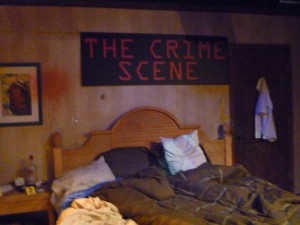Do you consider whether the punishment fits the crime? In the old days, the accused might choose a champion who fought for him. Nowadays, we hire lawyers to defend us in court. Truly, the pen is mightier than the sword. Other cultures are more brutal. If you’re caught stealing, they cut off your hand. They don’t make allowances for your troubled childhood or twisted mind. If you do a bad deed, you pay for it.
Some of these punishments are well illustrated at the Crime Museum downtown in Washington D.C. I’m doing a detailed walk-through of this experience on my personal blog along with photos, but suffice it to say that methods of crime detection and types of punishment have changed greatly through the ages.
Basically, the top floor of this fascinating museum gives a historical look at what counted as a crime beginning in medieval days and working its way through history toward modern CSI techniques. Did you know that you could be punished for kissing on the Sabbath during Colonial times? That was considered lewd and unseemly behavior, and you might even get your ears nailed to the pillory while you’re sitting in the stocks.
Interactive kiosks challenge you to participate. You can do fun things like shoot a Glock 17 at a police simulation, see how quick you can defuse a bomb, learn how to crack a safe, and match a bullet in the crime lab.
Today’s crime scene investigation involves science and observation. The public’s fascination is shown in multiple versions of Sherlock Holmes and CSI shows on television. More abhorrent are how criminals become celebrities. They’re certainly going to be satisfied if they commit their crimes for fame and recognition. Turn on the evening news, and watch the reporters talk about local murders ad nauseum.
Do today’s punishments fit the crimes? Or have we become too lenient, too civilized? Do punishments even work? Are they truly the deterrent they’re meant to be, other than keeping the bad guys off the streets? What about so-called “white collar” crimes? Rather than sitting in prison, should those criminals be put to work to compensate their victims or to educate others?
While highly entertaining, the displays in the Crime Museum make you think about the nature of crime, how the definition depends upon the culture, and whether the punishment is suitable and effective.







